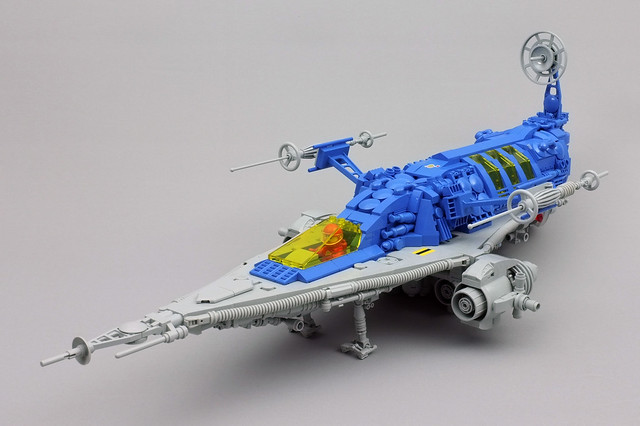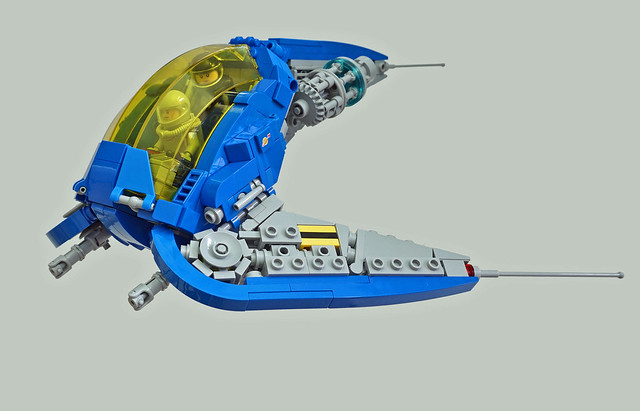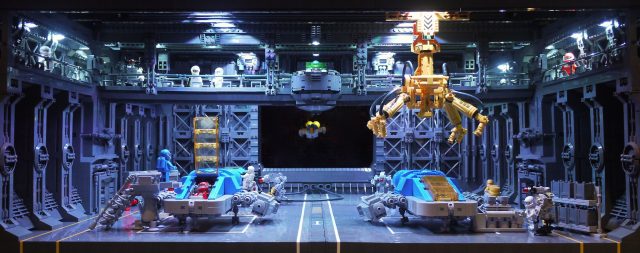The Brothers Brick Explore: LEGO Classic Space [Feature]
Classic Space – one of the perennial LEGO building genres, ever-popular amongst fans for its nostalgic nods to iconic official sets of the past, and the opportunities it presents to depict an optimistic expansionist vision of humanity’s intergalactic future.
This building genre takes its primary influences from the LEGO Space sets released between 1978 and 1987, and the follow-up themes released during the late-80s and beyond, when factions like Futuron, Blacktron, and the Space Police were introduced to the universe.
But the genre is about much more than just the official sets. Take a trip with The Brothers Brick as we blast off on our grand tour of LEGO Classic Space…
We have lift off!
It all began in 1978 when four new sets introduced the LEGO Space look and astronaut minifigures. The first Space minifigs came in white and red suits, but yellow spacesuits quickly followed in 1979, and blue and black joined the line-up in 1984. We had to wait until 2014 before we got green spacesuits, and then in 2019, we were treated to a hot pink spacesuit in the classic style. The range of colours will expand further in 2020 with an orange-suited Classic Space figure as an exclusive in the LEGO Minifigures Visual History book. It seems there’s a never-ending appetite for LEGO Space figures.
The iconic set from the theme’s early line-up was 1979’s Galaxy Explorer – also known as Space Cruiser & Moonbase, depending on the region where it was sold. The large spaceship featured a rear compartment for storing a moon rover, and was paired with a small command station sitting on a lunar surface baseplate. Galaxy Explorer fixed the design style for the official sets which followed, and influenced the overall visual tone for the entire genre.
In 1987 when the original Space line morphed into Futuron, the colour scheme got a refresh with white and transparent-blue cockpits, and the moon base got an upgrade with the introduction of the much-loved Monorail Transport System. At the same time, the previously peaceful exploration of the galaxy became a more fractious affair with the arrival of the theme’s first “bad guys” – Blacktron – with their distinctive black spaceships, complete with yellow highlights and transparent-yellow cockpits.
Over the years, more factions were to follow, with heroes like the Space Police and Unitron defending civilian space-workers from villainous adversaries such as Spyrius. These adventures took place across a range of environments – from the mining colonies of M:Tron to the frozen wastes of the Ice Planet, and more recently on the dusty surface of Mars.
However, the 40 years of official sets are only the beginning of the LEGO Space story. Classic Space is a popular genre for custom models, many taking inspiration from the Classic sets, but utilising up-to-date parts and building techniques in a style often referred to as “Neo-Classic Space”. We caught up with some of the LEGO builders who have specialised in the genre to discuss the enduring appeal of the theme, and some of its key aspects in more detail.
Alec Hole and Jeremy Williams are well-known “Spacers”, regularly building elaborate models using the signature elements of the style. Tim Goddard and Peter Reid collaborated on the 2017 book LEGO Space: Building the Future, and Peter was the fan designer behind 2014’s LEGO Ideas Exo Suit. Together they make for a fully flight-certified team to take us on a journey into LEGO Space…
The Brothers Brick: What do you love about the Classic Space theme? What attracts you to building in this style?
Peter Reid: I have very fond memories of playing with the original Classic Space sets as a child. They were such good toys. I’ve always been a fan of science fiction, and the Space building style is a great way to explore a cool design path in LEGO building.
Jeremy Williams: I think what primarily motivates many of us Spacers is nostalgia. We grew up with Classic Space in our childhood. That blue and grey colour scheme is an instant trip back to the late-70s and early-80s. What I loved about Classic Space was the sense of discovery, of relatively peaceful exploration, and the joy of building a range of complementary sets to fill out a compelling drama. Each new set added another episode in a daily adventure, and the box art, even if simple by modern standards, fuelled that spirit of exploration.
Alec Hole: The first LEGO set I was given was 6801 Moon Buggy (although it’s actually a hover scooter rather than a buggy!) I was fascinated by all the details in it. I loved space exploration, and the Classic Space sets allowed me to escape into my own little galaxy. I build in the style now partly from nostalgia for that optimistic view of the future, but also to imagine how we might travel further into outer space one day.
Tim Goddard: For me, the appeal of building in the theme lies in a combination of nostalgia and the constraints the Classic Space “rules” impose. Creativity needs boundaries, otherwise it can become too open and difficult. The boundaries of a style actually give you freedom to explore. I find having a fixed set of colours or guidelines gives me something to build on.
TBB: What are the key elements of the style? What makes a LEGO build Classic Space instead of just regular sci-fi?
Jeremy: The most obvious style markers are the colours – spaceships should have crew compartments in blue, with transparent-yellow glassware. Other hardware like wings, engines, and antennae, should be in light grey – or more usually nowadays, light bluish grey. This is the most common colour combination. There are more detailed “rules” concerning red and green indicator lights, and the yellow and black “bumblebee stripes”.
Alec: There are different views on how faithfully you should match the colour schemes. There’s also debate on whether Classic Space stops in the late-80s with the introduction of the factions like Futuron, Blacktron, and the Space Police. Spyrius [in 1994], and maybe Exploriens [in 1996], were the last ranges I’d still consider giving the Classic label to. The Insectoids theme which followed later [in 1998] was just a bit too weird!
There will often be an obvious reference to the style of the original LEGO Space sets. My Long Range Scout spaceship was inspired by a Space model from a 1985 LEGO Ideas book. There were no instructions for the original model, but I liked the look of it and used it as a springboard for my own design…
LL 228 Long Range Scout by Alec Hole
Tim: I am not sure there are any key elements apart from the colours, and even the colours can be open to interpretation and development. As for designs, I’ve seen things from Star Wars and Overwatch recreated in the blue, grey, and transparent-yellow colours. Are they still from those themes, or are they now Classic Space models? Maybe the iconic Space minifig is the only key element. But even that can be open to development – isn’t that right Benny?!
Peter: I tend to use a blue, grey, and transparent-yellow colour scheme similar to the iconic Galaxy Explorer set. I also like to include the bumblebee stripes and a few fancy build techniques. My models are usually smooth on the top with “greebly” details on the underside. These are just guidelines really, it’s all a matter of personal taste, but I do think a well-blocked colour scheme is an important part of making something look like a Neo-Classic Space model.
TBB: How have LEGO builders taken the Space theme forward from the original official sets?
Jeremy: For me, there’s a distinction between Classic Space and Neo-Classic Space. There are plenty of builders whose goal is to collect and display original sets, or to design models that entirely complement the originals, using techniques and parts only from that time. On the other hand, Neo-Classic builders aim to retain the spirit of the originals whilst using the latest parts and techniques to reboot the theme. I’m firmly in this latter group.
Peter: The Neo-Classic Space builders have put some gorgeous models out there, and helped create a rich shared universe for everyone to be inspired by. Plus there are always exciting new parts, which keeps things interesting with the development of clever new techniques. And the types of models have expanded too – it’s not just spaceships. Personally, I’m fond of making figure-based scenes with down-lighting, or building rooms like laboratories or workshops which you might find in a moon base or space station…
Classic Space Corridor by Peter Reid
Jeremy: Sophisticated techniques and using new connections and parts mean many Space creations now bear closer resemblance to the kit-bashed models used in sci-fi film-making than to the 70s Space sets. However, many of these modern models can sacrifice playability – a shame, given the original sets often included play features like opening hatches, or ships which split into smaller vehicles. It’s always a delight when a builder includes play features in a modern model.
Tim: As new parts are released Classic Space builders will be there to use them, and that keeps things fresh and innovative. Interesting new parts can take shapes well beyond the flat studs-up builds of the original sets. A new transparent-yellow cockpit piece always gets the creative juices flowing. I created the ship below purely to use a new yellow windscreen which appeared in a Star Wars set…
Blue Auk by Tim Goddard
Alec: Thanks to new parts, we can build designs with curves and organic shapes as well as angular styles, and techniques which hide studs make models appear smoother or more realistic. Many sci-fi movies depict spacecraft and future technology with an industrial feel using detailed “greebling”. This effect is often created from odds and ends kit-bashed together by the studio’s props department. LEGO is suited to this style – combining parts in unusual ways to build up layers of functional-looking detail.
It’s fun when builders add to the Classic Space universe. There were never any sets with giant space station hangars, but there are modern models imagining these in a Classic Space style. Jeremy built an excellent one back in 2014…
Classic Space Hangar by Jeremy Williams
TBB: If there were a single LEGO piece which summed up Classic Space what would it be?
Alec: I’d say the Slope 45 2×2 with Computer Panel Pattern. It was in my first Space set and I was entranced by it. As computers go, it looks a bit retro now, but it seemed very futuristic back then. According to the 80s box art, exploring outer space was exciting but also daunting – all those dusty planets and cold skies filled with distant stars. Those astronauts had nothing to help them but a trusty computer and maybe a friendly robot. The technology must have been pretty reliable – the astronauts were always smiling!
Peter: For me, it’s the 3×6 slope with the planet and rocket symbol. It’s a gorgeous version of the Classic Space logo.
Tim: I am going to go with a cockpit here – Windscreen 6x4x2 Canopy in transparent-yellow. Just as useful today as it’s always been and still looks good in a modern build due to its simplicity.
Jeremy: I’d pick the minifig air tanks. I know they were used for divers as well, but there was barely a Space set without them. The air tanks stood for brave adventures in dangerous vacuums – summing up the appeal of the whole theme. And remember those original LEGO Space crews were rarely protected by enclosed cockpits or pressurised bases. [TBB: or even helmet visors!]
TBB: What hints and tips would you have for anyone wanting to get into building in the Classic Space theme?
Tim: Other people’s work is a constant source of inspiration, as is a decent brick collection. Stock up on your blue, light bluish grey, and transparent-yellow – and then just start building. Build something that interests you – if you love cars build a moon rover, if you love planes build a starfighter, or if you’re into robots start there. Don’t get too hung up on the “rules” – give it your own spin!
Peter: Be inspired by the images posted by LEGO builders you admire. So many talented builders have made stunning creations in the Neo-Classic Space style, and their work is well worth studying. It takes time to get parts and make all the right moves, so be patient. It took me over a year to build and refine this spaceship – the LL-497 Galactic Explorer, a tribute to the theme’s most famous set…
LL 497 by Peter Reid
Alec: I built my own Space models as a kid, but when I discovered the AFOL scene I was a little daunted by the range of complex building techniques that had sprung up since the 80s. But by staring at a lot of Space models on Flickr I gradually worked out how people achieved things. It can be a bit slow to begin with, but you pick up different tricks and then develop your own. You could also start by customising a Classic Space set, rebuilding sections of it using different techniques and modern parts.
I’d also recommend going to shows and seeing other people’s models “in the brick”. If you ask nicely they may even let you swoosh them! But please be careful – unfortunately I’ve gained something of a reputation for dropping things!
Jeremy: The best way to get started is to head for the top of a hill at midnight on a clear moonless night. Pace in a wide circle, wearing nothing but transparent-yellow undergarments and with a Classic Space logo drawn on your torso with red and gold Sharpies. Call thrice for the spirits of the Neo-Classic Space-clan to possess you. That should do the trick!
TBB: Good advice there Jeremy – we’ll scout out an appropriate hilltop! Thank you all for your time, and good luck with your ongoing travels in the LEGO Space universe.
In celebration…
As well as contributing to our overview of the theme, Tim, Alec, and Jeremy each put together a new LEGO creation to celebrate the Classic Space genre.
Tim took inspiration from a mission NASA are currently planning – to travel to Titan, one of Saturn’s moons. If all goes well a drone called Dragonfly will be zipping around Titan’s thick atmosphere in 2034, on the lookout for evidence of life. Themes of exploration and discovery tie the very first LEGO Space sets to these cutting-edge real-world space experiments of today, and of the future.
Tim’s model is named Dragonfly 2. It is Tim’s design for the vehicle humanity will first use to investigate the carbon-rich chemistry of Titan in person, and to visit its methane lakes…
Tim also built a cool little robot to accompany our intrepid travellers on their trip to Titan. No Classic Space mission is allowed to proceed without a cute beeping and blooping companion. Meet Nymph, your new robotic monowheel pal…
Alec put together a single-seater spaceship inspired by the small craft common in the earliest Classic Space sets. Its all-grey, all-greeble construction may eschew the comfort of an enclosed cockpit, but all those pointy bits at the front, coupled with the pilot’s stern face, suggests this beastie might pack quite a punch.
Even better, Alec also built a launch pad and moon base home for his ship. The command pod is festooned with an impressive set of sensors, and in a nostalgic nod back to the Futuron-era, there’s a monorail connecting pod and pad…
Jeremy went microscale, building a sleek interceptor craft, packed full of interesting angles. The use of smaller and textured pieces, and some smart stickering, create an impressive level of detail, making the model look much bigger than it really is. A great spaceship design coupled with some lovely photography and presentation makes for a brilliant little Classic Space tribute…
Take a space flight of your own…
We hope you enjoyed this overview of the LEGO Classic Space building genre, of how it has grown and evolved from the original sets of the 70s and 80s into one of the perennial favourites of modern LEGO builders. Who knows, maybe all this Space-stuff has got you reaching for the bricks to build something of your own in this iconic style?
If you need some further inspiration to get you onto the launch pad, check out these instructions for a pair of microscale spaceships, rover, and command post in the Classic Space style – put together by TBB’s own Rod Gillies.
The post The Brothers Brick Explore: LEGO Classic Space [Feature] appeared first on The Brothers Brick.



















